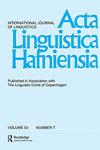Introduction: spatial language, cognition and environment
Q2 Arts and Humanities
引用次数: 0
Abstract
The languages of the world offer their speakers different means of encoding spatial information and of grounding utterances geographically by pointing to the surrounding landscape. Languages vary both in the spatial concepts they require their speakers to hold and in the degree of routine attention to the physical environment they demand. The five papers in this special issue illustrate crosslinguistic variation in coding strategies for spatial notions as well as methods for investigating such variation, two key themes for the conference Geographic Grounding: Place, direction and landscape in the grammars of the world, held in Copenhagen 30–31May 2016, where the content and perspectives of the five papers were first presented. This issue comprises studies in spatial coding strategies in West Greenlandic (Inuit, Greenland), Icelandic (Germanic, Iceland), Faroese (Germanic, the Faroe Islands), Kalasha and Palula (both Indo-Aryan, Pakistan), Diidxazá (Zapotecan, Mexico), Acazulco Otomí (Otopamean, Mexico) and Mexican Spanish (Romance, Mexico), and the contributions share a keen interest in contextualizing these strategies. On the one hand, the papers examine interdependencies between spatial subsystems within a language that either reinforce or supplement one another. On the other, they investigate the possible influence from spatial language on spatial cognition as well as the possible effects of geography and cultural practices on the structure of space-marking systems.导论:空间语言、认知与环境
世界上的语言为他们的使用者提供了不同的方式来编码空间信息,并通过指向周围的景观来在地理上奠定话语的基础。语言的变化既体现在要求说话者掌握的空间概念上,也体现在对自然环境的日常关注程度上。这期特刊中的五篇论文阐述了空间概念编码策略的跨语言差异以及研究这种差异的方法,这是2016年5月30日至31日在哥本哈根举行的“地理基础:世界语法中的地点、方向和景观”会议的两个关键主题,其中首次介绍了五篇论文的内容和观点。本期包括西格陵兰语(因纽特人,格陵兰)、冰岛语(日耳曼语,冰岛)、法罗语(日耳曼语,法罗群岛)、卡拉沙语和帕卢拉语(巴基斯坦的印度雅利安人)、diidxazan(墨西哥的萨波特坎人)、Acazulco Otomí(墨西哥的Otopamean)和墨西哥西班牙语(罗曼史,墨西哥)的空间编码策略的研究,以及对这些策略背景化的兴趣。一方面,论文研究了一种语言中空间子系统之间的相互依赖性,这些子系统要么相互加强,要么相互补充。另一方面,他们研究了空间语言对空间认知的可能影响,以及地理和文化习俗对空间标记系统结构的可能影响。
本文章由计算机程序翻译,如有差异,请以英文原文为准。
求助全文
约1分钟内获得全文
求助全文
来源期刊

Acta Linguistica Hafniensia
Arts and Humanities-Language and Linguistics
CiteScore
0.90
自引率
0.00%
发文量
5
 求助内容:
求助内容: 应助结果提醒方式:
应助结果提醒方式:


